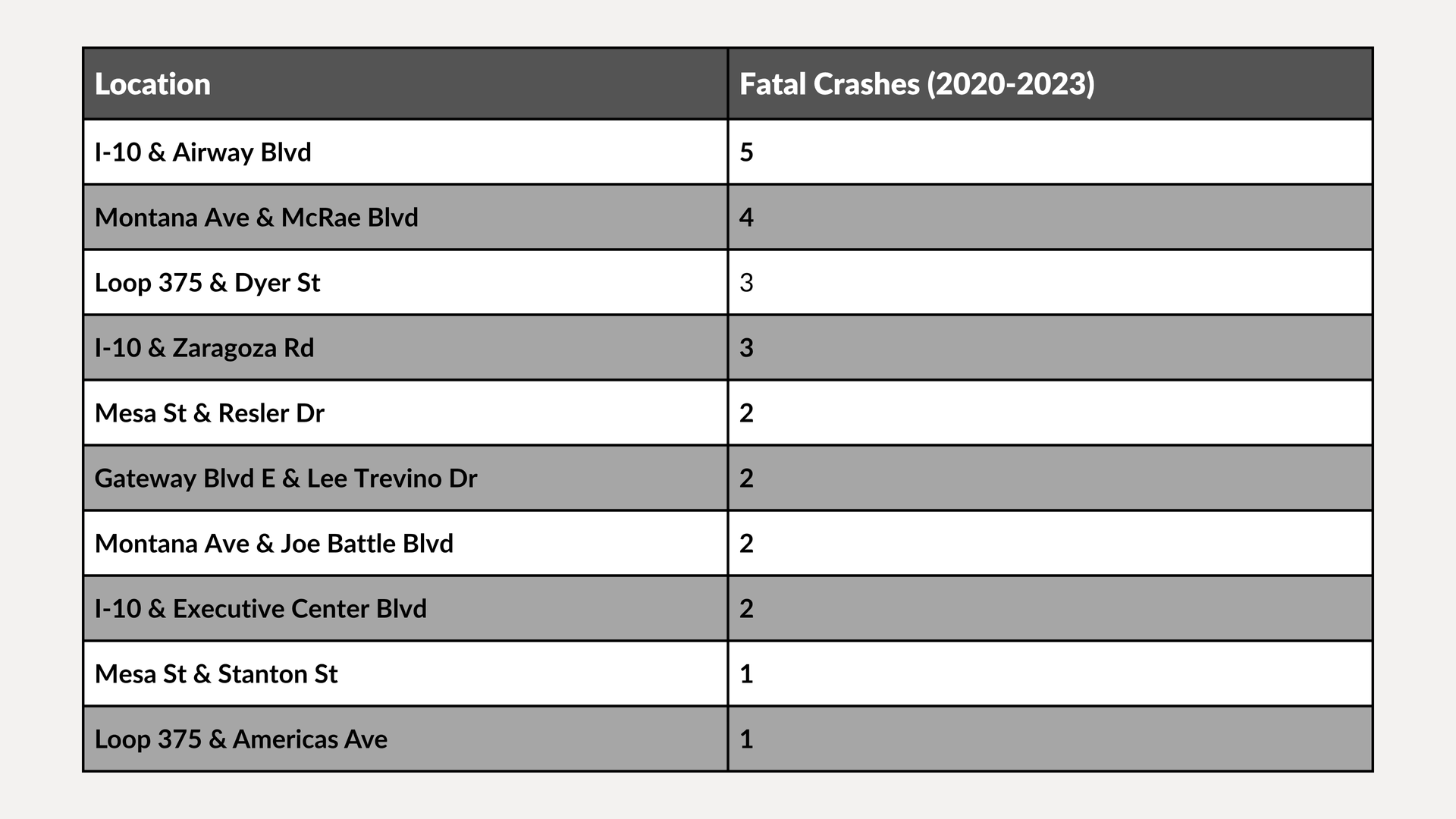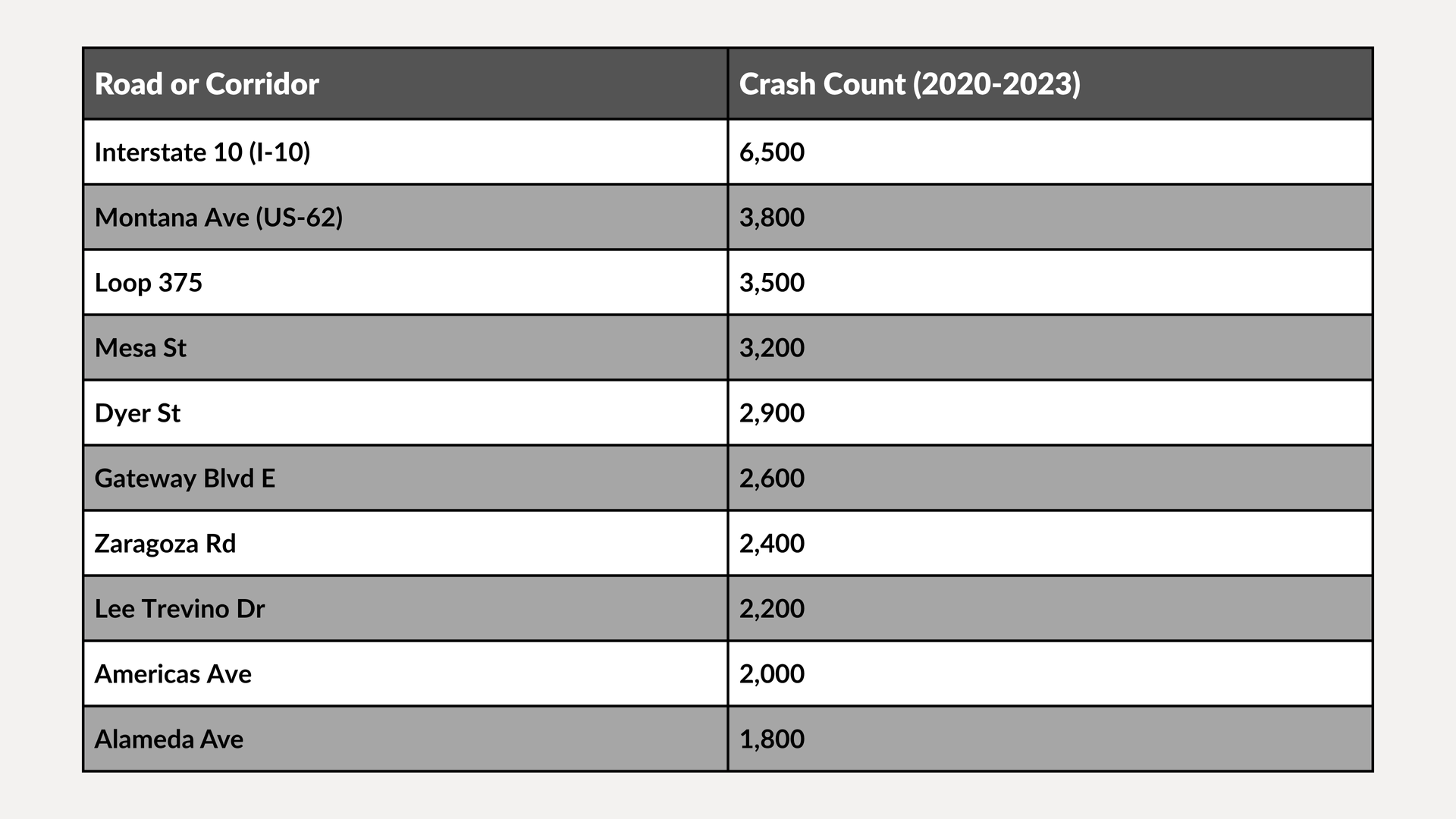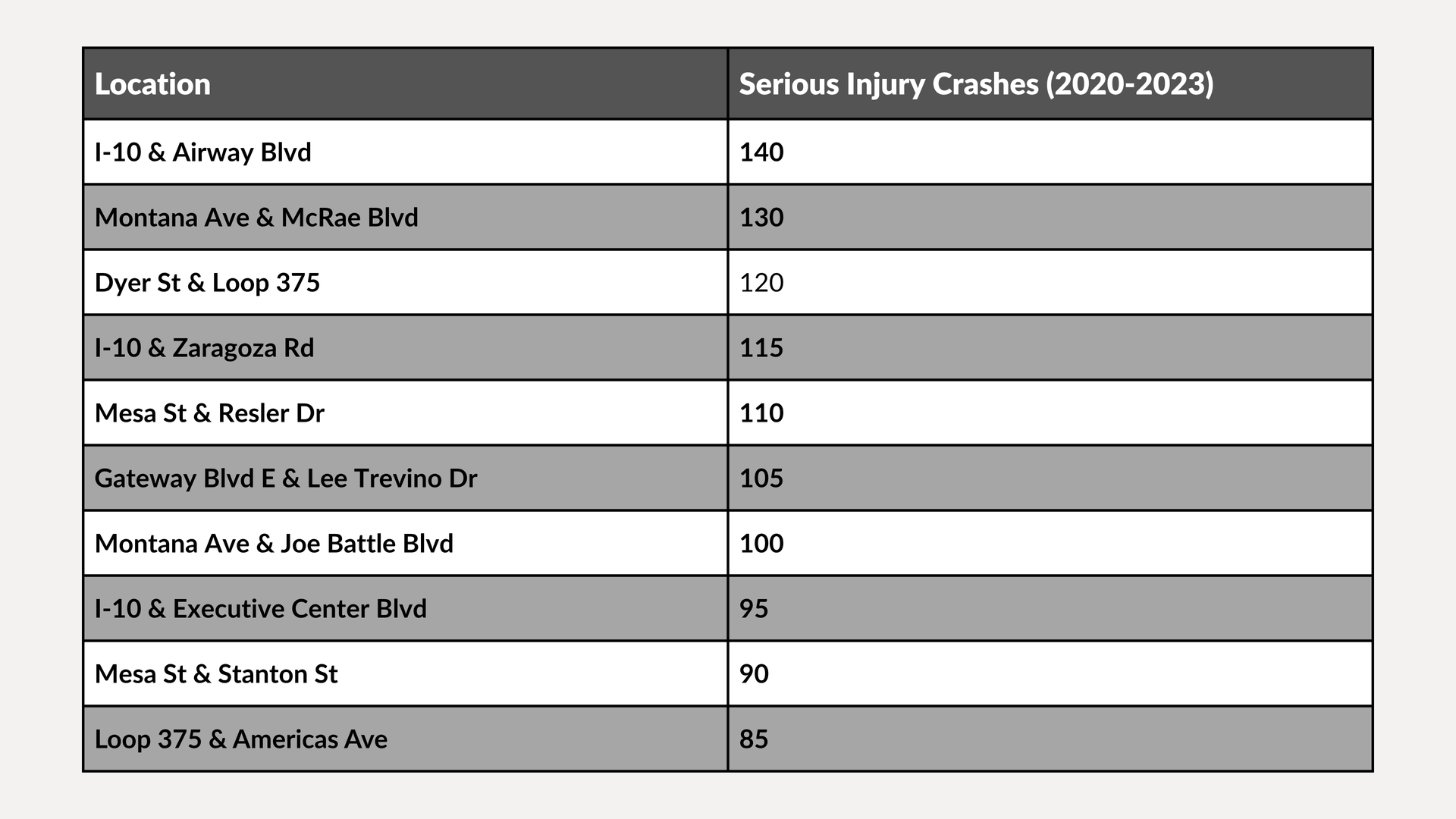The Most Dangerous Places to Drive in El Paso
The Crash Records Information System of the Texas Department of Transportation (TxDOT CRIS) reports that 13,627 crashes occurred in El Paso, Texas, in 2022 alone, a thriving border city with approximately 680,000 residents. As a major hub along Interstate 10 and the U.S.-Mexico border, El Paso sees heavy traffic from over 800,000 commercial trucks annually, contributing to congestion and crashes. Drawing on geocoded data from the El Paso Open Data Portal, NHTSA’s Fatality Analysis Reporting System (FARS), this guide uncovers El Paso’s most dangerous intersections, roads, and crash trends. For A2X readers, we break down where crashes occur, why they happen, and how to stay safe, while offering support to those affected by collisions in this bustling city.
Why El Paso’s Roads Are So Risky
El Paso’s roads are experiencing a crash epidemic due to its location as both a border crossing point and a central traffic hub on I-10. The highways in El Paso, such as I-10, which experienced 2,977 crashes in one year, will have drivers traveling at high speeds for long distances between exits. El Paso's highways are overwhelmed with commercial trucks and commuter traffic. Intersections, such as I-10 & Airway Boulevard, have experienced a total of 200 crashes from 2015 to 2019. This is due to the complexity of freeway access to the airport and other traffic. Speeding (accounting for 30% of Texas crashes, with 136,165 statewide in 2022) and distracted driving (resulting in 84,887 crashes) are the most prevalent causes of crashes, particularly at busy arterials such as Montana Avenue. Pedestrian safety is another major issue, because 2022 witnessed 78 pedestrian deaths, often staggering due to the lack of adequate crosswalks (near downtown, commercial, etc.). Pedestrian safety is a critical concern, with 78 pedestrian deaths in 2022, often due to inadequate crosswalks near downtown and commercial areas. Drunk driving, contributing to 16% of fatalities, spikes during late-night weekends, while construction zones on I-10 add further risks. El Paso’s Vision Zero initiative, backed by $40 million in state funding, aims to eliminate traffic deaths by 2030, but limited 2024 funding ($1 million) slows progress. With this information, A2X readers can advocate for safer streets and drive carefully on El Paso's roads.
El Paso’s Most Dangerous Intersections
It can be intimidating to drive through El Paso's intersections due to the heavy traffic, complex layouts, and constant presence of distracted drivers. Data from TxDOT CRIS, the El Paso Open Data Portal, and law firm reports (2015–2019) identify the city’s most crash-prone intersections, where injury and fatal crashes within 200 feet are alarmingly frequent, often near freeways or commercial hubs.

I-10 & Airway Blvd tops the list with 200 crashes, driven by congestion near El Paso International Airport and frequent rear-end collisions. With 180 collisions, Montana Avenue and McRae Boulevard have high crash rates due to their busy nature, which accommodates both pedestrian and commercial traffic. To avoid crashes in these places, increased attention is required.
El Paso’s Deadliest Crash Hotspots
In El Paso, fatal collisions frequently happen at intersections where cyclists and pedestrians are at risk or on high-speed highways. The city's deadliest spots, where speeding, intoxicated driving, and inadequate pedestrian infrastructure all contribute to terrible results, are highlighted by TxDOT CRIS and NHTSA FARS data (2020–2023).

Five fatal crashes near the airport have been connected to high-speed interstate traffic and access road confusion at I-10 & Airway Blvd. In addition to El Paso's 78 pedestrian fatalities in 2022, Montana Ave & McRae Blvd is a particularly hazardous intersection for pedestrians, accounting for four deaths. These hotspots highlight the need for improved safety procedures.
El Paso’s Most Crash-Prone Roads and Corridors
The heavy traffic on El Paso's highways and arterials, which includes both local commuters and trucks traveling across the border, makes them vulnerable to collisions. These roads are the most hazardous in the city, according to the TxDOT CRIS and the El Paso Open Data Portal (2020–2023), with a range of minor to serious collisions.

I-10, with 6,500 crashes, is the most dangerous road in El Paso. It alone experienced 2,977 crashes in 2019 due to its role as a commercial route and the long gaps in the exit ramps. In addition, Montana Avenue, which averages around 200 crashes per year, is another dangerous roadway that serves as an arterial with significant commercial traffic, and both roads run adjacent to commercial areas. Elements like these, whether minor or severe, are inherently dangerous on roads and should be approached with caution, especially during peak traffic hours.
Where Serious Injuries Are Most Common
Serious injury crashes in El Paso leave victims with life-changing consequences, often involving pedestrians and cyclists. TxDOT CRIS and El Paso Open Data Portal data (2020–2023) highlight the locations with the highest number of serious (non-fatal) injury crashes.

I-10 & Airway Blvd leads to 140 serious injury crashes, driven by high traffic volumes and pedestrian incidents near commercial areas. Montana Avenue and McRae Boulevard, with 130, experience high injury rates due to pedestrian and cyclist traffic, which is exacerbated by inadequate infrastructure. El Paso’s 3,166 injury crashes in 2021 underscore the urgency of safety improvements.
When and Why Crashes Happen
El Paso’s crashes peak during rush hours (3–8 PM), when commuters and commercial traffic clog roads like I-10 and Mesa St. Late-night weekends (6 PM–midnight) are especially dangerous, with drunk driving contributing to 16% of fatalities. August through October are the most crash-prone months, averaging over 1,280 crashes each in 2021, driven by seasonal travel and border activity. Key causes include:
- Speeding: A contributing factor in 30% of collisions in Texas; speeding is common on Loop 375 and I-10.
- Distracted Driving: Texting is a prevalent distraction at crossroads like Mesa Street and Stanton Street, which resulted in 2,611 crashes in El Paso in 2023.
- Failure to Yield: Accounts for 35,674 crashes statewide, leading to angle collisions at places like Gateway Blvd E & Lee Trevino Dr.
- Drunk Driving: A major factor in nighttime fatalities, especially near downtown nightlife areas.
Border-related truck traffic, with over 800,000 trucks annually, and construction on I-10 increase risks, while El Paso’s cell phone ordinance (banning all use while driving) aims to curb distracted driving.
Tips to Stay Safe on El Paso’s Roads
- Slow Down on I-10: I-10’s high speeds and truck traffic demand caution. Stick to speed limits, especially in construction zones.
- Watch for Pedestrians: intersections like Montana Avenue and McRae Boulevard have heavy foot traffic. Be alert for pedestrians and cyclists, especially in downtown areas.
- Avoid Nighttime Driving: Drunk driving spikes on weekends. Use rideshares services or a designated driver after dark.
- Navigate Construction Zones Carefully: Follow signage on I-10 and Loop 375, where lane shifts are common.
- Stay Focused: Put phones away, as El Paso’s ordinance bans all cell phone use while driving, especially at busy intersections like I-10 & Airway Blvd.
A2X Has Your Back After a Crash
A crash in El Paso can turn your life upside down, leaving you with injuries, bills, and stress. Our goal at A2X is to help you deal with the difficult aftermath by offering you compassionate support and knowledgeable legal advice. We will fight for your compensation regardless of how serious the injury is or whether you are seeking justice for your loved one. This is not something you have to face alone. To start the recovery process, get in touch with A2X today.
Request a Consultation
Other Practice Areas







